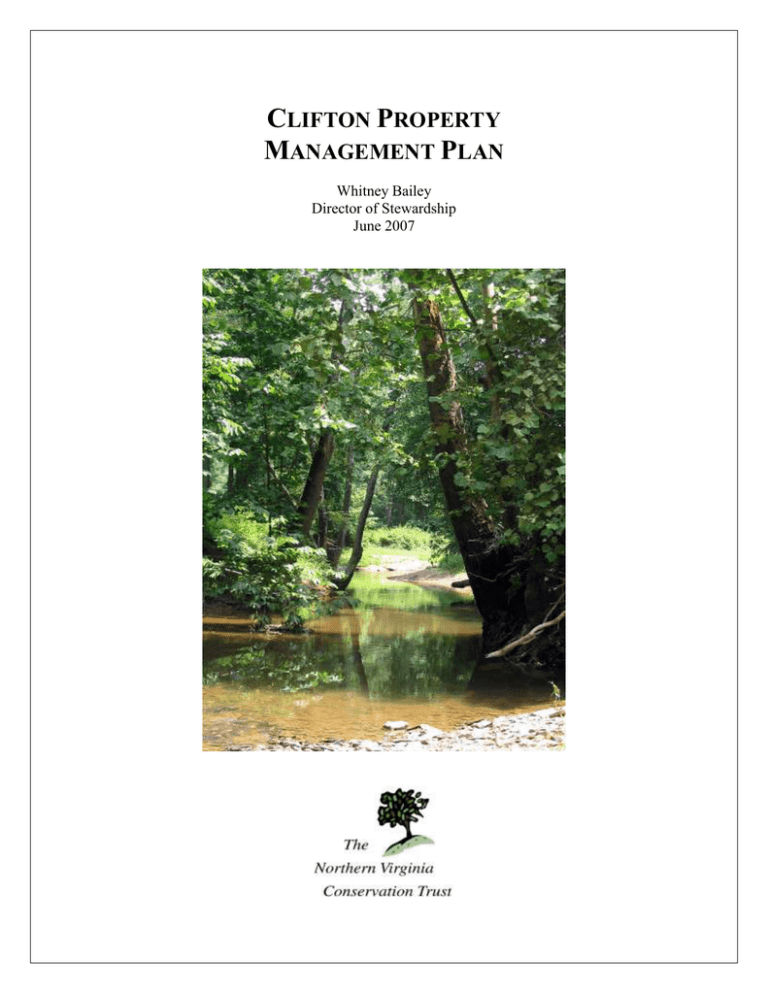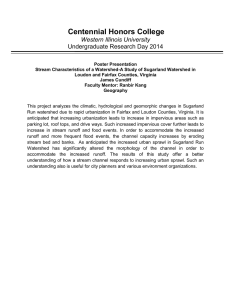C P M
advertisement

CLIFTON PROPERTY MANAGEMENT PLAN Whitney Bailey Director of Stewardship June 2007 Current Condition Natural features This property is mostly covered with mature bottomland forest, and Popes Head Creek runs roughly northeast through the center. A mowed recreational field lies to the west, and a meadow with a mix of native and non-native species lies to the east. The NVCT property lies mostly in the floodplain of Popes Head Cree, though flood events become less common as the stream cuts a deeper channel. Increasing impervious surface coverage in the watershed is intensifying stormwater impact, and some bank erosion is occurring in multiple locations. The soil within 30-50 feet of the stream center is mostly sediment deposition, and therefore sandy and usually damp; farther away the soil contains more humus due to less frequent flood events and a more stable vegetative community. Vegetation In the floodplain the vegetation density is varied, with some areas having a combination of thick native and invasive groundcover and heavily browsed understory, and other areas having less groundcover and more understory density (usually a mix of vines, thorny brambles, and native shrubs). Sunny areas have a higher prevalence of invasive species. Native species observed include Red Maple, Silver Maple, Box-Elder, Sycamore, Mayapple, Spicebush, Jewelweed, and multiple kinds of ferns and viburnums. Other likely species include, American Elm, Pin Oak, Scarlet Oak, Ironwood, Green Ash, River Birch, Alder No incidences of rare or threatened species are currently reported here. Invasives There is a strong invasive presence on this property, including Japanese Stiltgrass, Honeysuckle, Tearthumb, Multiflora Rose, Bittersweet, and Porcelainberry. Sunny areas have a higher prevalence of invasive species. Wildlife Popes Head Creek supports a wide diversity of fish and some aquatic insects, and probably a proportionate number of amphibian species. Habitat diversity is also high with edge habitat, forest interior, and riparian areas suitable for a wide variety of reptile, mammal, and bird species, though the increasing prevalence of invasive plant species is likely having a negative effect on biodiversity. No incidences of rare or threatened species are currently reported here. Background & Setting According to Fairfax County’s 2001 Stream Protection Study (SPS), prepared by DPWES, (see attached), it is one of the healthiest streams in Northern Virginia, still home to at least 19 species of fish. Surveys for invertebrates yielded poorer quality results, however, with tolerant taxa dominating and more sensitive species uncommon. The habitat scores were also low, with impervious surface increasing and many areas of local disturbance, and overall mild degradation. The contradictory biotic data and the general low-level degradation may indicate recent decline of system integrity or the presence of other unknown environmental stressors. Nonetheless the area the property lies in scored highly enough to be classified as a Watershed Protection Area by the county, requiring the least active management. In addition to zoning, regulatory, and policy objectives to maintain high water quality, the SPS area goals for the area include: “Assess current watershed conditions to identify characteristics and management practices that contribute to the high water quality rating.” “Expand stream valley park acquisition or dedication.” “Conduct public education programs on stream stewardship.” NVCT Management Goals To maintain the conditions which contribute to high water quality and wildlife habitat integrity, and to expand beneficial conditions and improve low-quality conditions where possible. To assist the county and local groups with watershed education for local citizens. Workplan Identify areas with poor quality habitat and the factors that need to be improved Conduct invasive species removals where necessary and monitor results, repeat as necessary Conduct native tree plantings where necessary using DOF and nursery stock Work with Town of Clifton government on planning process for Clifton Park, which lies on the property Work with Fairfax County and Town of Clifton and local groups on watershed education events and opportunities, including stream monitoring education seminars and interpretive signage in Clifton Park.

